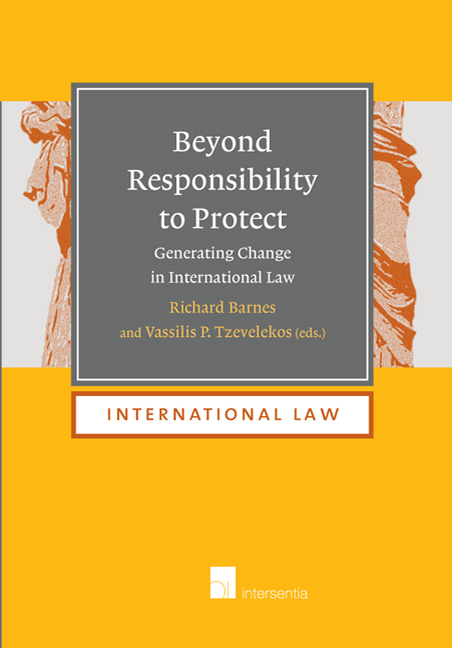Book contents
- Frontmatter
- Dedication
- Foreword
- Acknowledgements
- Contents
- Table of Cases
- List of Authors
- Introduction
- Part I The Moral Underpinnings and Political Ends of R2p
- Part II International Institutions And Their Role In R2p
- PART III De Facto Regimes and Non-State Actors Within a State And as a State
- Part IV R2p and Due Dilligence Regarding the Conduct of Corporations
- Part V The Interaction Between R2p And Humanitarian Law Obligations To Protect Civilian Populations
- The Responsibility to Protect Doctrine, and the Duty of the International Community to Reinforce International Humanitarian Law and its Protective Value for Civilian Populations
- The Responsibility to Protect in Armed Conflict: A Step Forward for the Protection of Civilians?
- Commentary: On the Intersection of the Responsibility to Protect, the Protection of Civilians and International Humanitarian Law in Contemporary Armed Conflicts
- PART VI R2p and International Criminal Law Beyond the Four R2p Crimes
- Part VII R2p and its Possible Impact on the Law of International Responsibility
- Part VIII Concluding Observations
- Index
The Responsibility to Protect in Armed Conflict: A Step Forward for the Protection of Civilians?
from Part V - The Interaction Between R2p And Humanitarian Law Obligations To Protect Civilian Populations
Published online by Cambridge University Press: 19 September 2018
- Frontmatter
- Dedication
- Foreword
- Acknowledgements
- Contents
- Table of Cases
- List of Authors
- Introduction
- Part I The Moral Underpinnings and Political Ends of R2p
- Part II International Institutions And Their Role In R2p
- PART III De Facto Regimes and Non-State Actors Within a State And as a State
- Part IV R2p and Due Dilligence Regarding the Conduct of Corporations
- Part V The Interaction Between R2p And Humanitarian Law Obligations To Protect Civilian Populations
- The Responsibility to Protect Doctrine, and the Duty of the International Community to Reinforce International Humanitarian Law and its Protective Value for Civilian Populations
- The Responsibility to Protect in Armed Conflict: A Step Forward for the Protection of Civilians?
- Commentary: On the Intersection of the Responsibility to Protect, the Protection of Civilians and International Humanitarian Law in Contemporary Armed Conflicts
- PART VI R2p and International Criminal Law Beyond the Four R2p Crimes
- Part VII R2p and its Possible Impact on the Law of International Responsibility
- Part VIII Concluding Observations
- Index
Summary
INTRODUCTION
In 1999, at the initiative of Canada, the members of the United Nations Security Council (UNSC) agreed to focus on a thematic issue devoted to the protection of civilians in armed conflict (POC). Since then, the UNSC has normally met twice a year in order to discuss this issue. It has adopted several resolutions specifically on the POC as well referring to it in many resolutions dealing with particular crises. Although the questions addressed under POC have slightly evolved since 1999 international law and, in particular, international humanitarian law (IHL) remain the central pillar of this thematic issue.
Recent practice evidences a clear trend towards associating the responsibility to protect (R2P) with POC. This may be first noticed in UNSC resolutions dealing with POC in general, including Resolution 1674 (2006), which was also the first resolution in which R2P was mentioned, and Resolution 1894 (2005), which expressly considers the famous paragraphs on R2P in the World Summit Outcome Document (WSOD) as being part of ‘the provisions regarding the protection of civilians in armed conflict’. This tendency also appears in recent UNSC resolutions dealing with specific crises, for example, Resolutions 1970 (2011) and 1973 (2011) on the situation in Libya, as well as Resolution 1975 (2011) on the situation in the Ivory Coast. In these Resolutions, R2P and POC are mentioned together in a paragraph of the preamble, each of which is formulated in a similar way. Finally, the association of R2P with POC is apparent in the declarations made by the states at UNSC meetings on POC where a number of states link the two concepts. Some do it implicitly while others do so explicitly. Among the latter group of states are Sweden and the United Kingdom, both of whom expressly consider R2P to be one of the key elements of the POC normative framework. This position is in line with the one adopted by the UN Secretary-General in his 2007 report on POC (although the position of the UNSG changed sensibly in his 2012 report on the subject). Some states, such as the Netherlands, even emphasised the common features shared by the two concepts before expressly arguing in favour of their association.
- Type
- Chapter
- Information
- Beyond Responsibility to ProtectGenerating Change in International Law, pp. 269 - 286Publisher: IntersentiaPrint publication year: 2016

